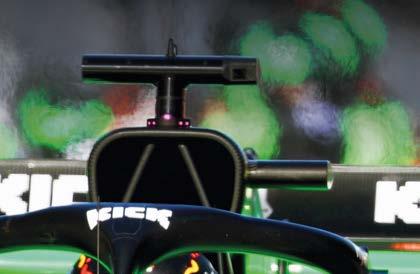Inside the world of modern motorsport technology











































Sauber’s C44 weighs in under the 798kg minimum, and carries ballast that is attached to the survival cell, although Key is not willing to disclose how much

Sauber F1 technical director, James Key, explains how the Swiss team aims to lay a solid foundation for Audi’s arrival in 2026
By DANIEL LLOYD

Honda has taken the bold step to radically change its GT500 contender for 2024 and acknowledges that, in doing so, it has given itself a mountain to climb
By JAMIE KLEINThis is the first time any manufacturer has opted to use a front-wheel drive, fivedoor hatchback as the basis for its GT500 challenger

Believe it or not, Super GT heavily limits the amount of aerodynamic development that can be done, so choosing the right base car is crucial to success in the series

Engineering and data matters at BTCC rounds are directed from TOCA’s technical truck, giving the series a clear picture of what’s going on
The British Touring Car Championship (BTCC) is now in its third season with hybrid powertrain technology. Each campaign of the TOCA-run series’ electrified era has resembled a different stepping stone in the journey so far. Year one was about getting to grips with the 48V system, year two exposed some of the sporting shortcomings, and year three is now about making improvements.
The headline change for 2024 is an increase in boost from the hybrid powertrain, which consists of a Cosworth hybrid system, Xtrac gearbox, Owen Developments turbo and an engine of the competitor’s choice.
Through upping the turbo, the amount of power available to each driver at the push of a button, for up to 15 seconds per lap, has doubled to around 60bhp. This is part of a drive to maintain the BTCC’s reputation as one of the most competitive series in the world.
An exciting on-track product, combined with a free-to-air television package on ITV, has been the recipe for huge success in recent years. However, last season, TOCA management figures took note of areas in the hybrid deployment that could be improved.
The wild variations in performance that occurred under the old success ballast system had become less noticeable, resulting in fewer overtakes. As BTCC technical director, Sam Riches, admits, the on-track competition ‘has not panned out as expected’.
The low voltage, regenerative braking hybrid system was introduced as part of the BTCC’s efforts to promote sustainability and road relevance. As a championship with manufacturer involvement from Ford, Toyota, Hyundai and BMW, it was an unsurprising move. It was also a pioneering

one, as the BTCC became the world’s first hybridised touring car championship.
Aside from backing automotive industry trends, it was hoped that new strategic options and engineering challenges for the teams would arise.
Hybrids replaced the previous success ballast system used by the series so, rather than being laden with extra weight (up to 75kg, depending on the previous race result), successful drivers would instead have fewer laps to deploy hybrid power and higher minimum deployment speeds.
On a technical level, the hybrid system needed to produce a certain number of metres per second for a chasing car to pull alongside the vehicle in front. To complicate matters, that had to apply at all BTCC tracks, from a compact venue like Brands Hatch Indy, to somewhere like Silverstone, which boasts the long Wellington Straight.
The BTCC became the first touring car series to use hybrid power when the Cosworth system arrived in 2022. It has worked on matching the technology to its proven racing product since then

The on-track competition ‘has not panned out as expected’
Sam Riches, BTCC technical director



Sporting Trials is all about accuracy and car control, driving lightweight, rearwheel drive machines up steep, twisting, often muddy sections without hitting the poles that mark the route or allowing the car to stop


With ddle brakes, propanefuelled engines and tyres that can run as low as 3psi, Sporting Trials is a very di erent form of motorsport, arguably the slowest aroundBy MIKE BRESLIN
The creation of the FIA GT Championship prompted Mercedes-Benz to build a new racecar for 1997. The CLK-GTR was the German manufacturer’s impressive answerBy KARL LUDVIGSEN
Mercedes-Benz has always had a knack for designing and building handsome, two-door coupés, from the older 220 saloons to the modern S-Class, combining sporty looks with high equipment levels and an extra touch of customer-pleasing quality.
This tradition was well upheld by the CLK coupé, launched by Mercedes-Benz for the 1997 model year. Based on the C-Class platform, the CLK’s handsome shape and new, three-valve, 3.2-litre V6 engine ‘awakened passions’, as company chief, Helmut Werner, said at the time, both within and outside Mercedes-Benz AG.
The new CLK also ‘awakened passions’ at Affalterbach, north east of Stuttgart. There, in 1996, the racers of AMG were giving thought to their plans for the 1997 International Touring Car Championship (ITC) season.
Much as Opel had used the Calibra coupé as the basis for its DTM / ITC car, this avenue also seemed open to Mercedes-Benz.
‘We did a styling study for an ITC car related to the CLK,’ engineer, Gerhard Lepler, said, ‘to show the members of the board what such a car could look like. This was done using the basis of an old 1994 DTM car, on which a new body was fitted.’
However promising the mock-up looked, it became redundant with the expiration of the short-lived ITC at the end of 1996.
In the meantime, motorsports chief, Norbert Haug, and his colleagues had been tracking developments at the FIA in the field of Grand Touring, or GT racing, which pitted high performance sportscars with closed coupé bodies against one another.
Since 1994, the BPR Global GT Series had been privately run, but proved so successful
